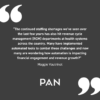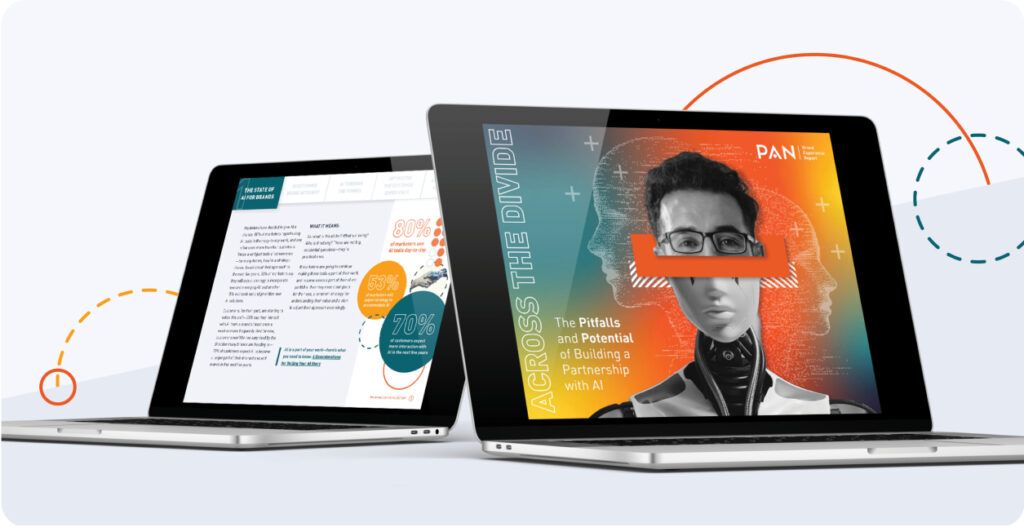The healthcare market has undergone significant innovation and advancement in the past eight to 10 years, driven by an overall need to catch up to other industries, create efficiencies at scale, and improve experiences with and within the system. Meaning, there is a solid foundation in place across the spectrum and 2023 should see the continued merger of technology with business and clinical operations and workflows to further address many of the challenges that have become glaringly apparent in the years prior.
Yet, as my colleague Matthew Briggs outlined in his recent blog, the sentiment coming out of both HLTH 2022 and JPM as well as what we are seeing in our daily work with some of the brightest healthcare companies, their leadership teams, and their investors/boards, is cautious optimism.
As we start to emerge from Q1 and look ahead to HIMSS 23 and ongoing 2023 healthcare trends, rising interest rates, continued supply chain issues and further inflation are still having an impact, not to mention healthcare- worker shortages (impacting all sectors from biopharma and life sciences to hospitals and health systems to payers and employers). So, what does that mean for the sector at large and, specifically, for digital health brands?
worker shortages (impacting all sectors from biopharma and life sciences to hospitals and health systems to payers and employers). So, what does that mean for the sector at large and, specifically, for digital health brands?
No one knows for sure, but it is safe to say that, likely, the market will see an increase in smaller funding rounds as VCs remain cautious and feel out how impactful the economic headwinds will be longer-term. The digitization of the industry at large will continue, no doubt, and technology will continue to help address healthcare challenges, but there may be more of a focus on specific sectors such as mental health, which saw a small rebound in Q3 2022 (after a few down quarters), complex disease states (e.g. oncology) and nonclinical workflow solutions to name a few.
2023 Healthcare Trends and News Drivers
We’ve gone ahead and identified some of the key healthcare trends and themes we expect to be prominent at HIMSS 23 and throughout the remainder of the year despite the macro issues taking shape around us. These themes cut across all key audiences including payers, providers, employers, biopharma and life sciences.
Patient engagement and patient experience
Patients today have become savvier and more proactive regarding self-care and are working together with providers (and payers) to take a more proactive vs reactive approach to care. This approach leads to better quality of care and life, but is dependent on a patient journey that is personalized so individuals can remain engaged in their care.
Patients with better care experiences often have better health outcomes. For example, within the provider setting, take patients hospitalized for heart attack. Studies have shown that patients with more positive reports about their experiences with care had better health outcomes a year after discharge. Increasing patient engagement relies heavily on improving patient experience. Reducing friction points by simplifying processes has become common practice — and what consumers are used to — in all other industries they interact with.
Healthcare organizations need to better consider this and understand that patients are accustomed to interacting with brands (and this now needs to include healthcare brands) in a seamless, frictionless and user-friendly way and if they don’t have a good experience they will quickly leave and find one that will offer the experience they desire. Yet, experience and engagement aren’t reduced solely to the provider world. Better patient engagement can help payers to both improve member health while also reducing costs via more targeted, personalized outreach, early intervention and inspiring members to change unhealthy behaviors.
Artificial Intelligence (AI)
AI is one of those healthcare trends that has been on every radar and prediction list for the past several years. And, here it is again. However, after years as a buzzword and with inflated promises, 2023 should be the year that the fluff becomes a reality and AI finally shows tangible impact in the industry — from improving patient care with  data-driven clinical decision-making to streamlining healthcare system workflows to drug discovery by assisting with predicting outcomes of clinical trials and potential side effects of new drugs.
data-driven clinical decision-making to streamlining healthcare system workflows to drug discovery by assisting with predicting outcomes of clinical trials and potential side effects of new drugs.
A few specific examples of AI in action on frontline clinical work include the analysis of medical imagery using computer vision algorithms to spot early warning signs of disease, and detecting and treating neurological disorders such as Parkinson’s and/or Alzheimer’s Diseases. On the payer side, AI has applications in clerical work, such as processing insurance claims. Within the provider network, AI can be useful in the management or analysis of medical record keeping and also be used to analyze data collected from patient wearables or in-home sensors used in virtual hospital settings.
Mental health
Investment in digital mental health solutions is on the rise and an increasing number of vendors are entering the market to help address this critical issue. Tech-enabled platforms enable more access to mental health services and connect patients with mental health providers. Through telehealth, on-demand, anytime therapy right from a mobile phone is what patients are demanding and also now a reality. Many employees now expecting their employers to offer mental health support.
According to a recent Becker’s survey, 84% of employees cited “robust mental health benefits” as a factor when considering a new job. Employers must think carefully and strategically about addressing mental health for their workforces — including global workforces. And, as is always the case, it comes back to money and how these mental health services and benefits will be paid for and the payers’ role in working to manage coverage mechanisms such as Medicare, Medicaid, Exchange and commercial populations specific to mental health care provided via telehealth. Additionally, payers will need to continue to grow their behavioral health networks so that members can access care quickly and have choice and flexibility when accessing that care.
Personalized healthcare
As patients take a more involved approach to their own care, the notion of personalized experiences will continue to be a focus across the healthcare sector. Patients increasingly have a desire for their healthcare to be seamless, holistic, and easily integrated into daily life, including ease of communication, availability of virtual visit options, coordination among care teams, and text messages and ‘just-in-time’ reminders, to name a few.
Additionally, as we look at personalized healthcare, the notion of precision medicine will continue to evolve (where drugs and treatments are tailored to individuals — taking into account such factors as age, genetics or risk factors – rather than administered on a one-size-fits-all approach). Within the payer space, personalization — much like engagement and experience discussed in the trend above — is critical. Communicating with members not just through the channels they desire based on their preferences but also with a relevance to each member’s care is important to retaining members but also to early interventions, lowering costs and getting members the ongoing and preventative care they need to stay healthy.
Wearables
Adopting wearable healthcare technologies is another healthcare trend that has appeared on prediction lists for the past several years … and is continuing to increase in adoption and utilization as individuals take more ownership over their own healthcare. Continuous health monitoring through health wearables enables personalized, data-driven care where the clinician and patient take a proactive rather than reactive approach.
Additionally, digital health software applications and sophisticated hardware provide individualized vital data and biomarkers and play a critical role in disease prevention. Furthermore, wearable devices, mobile technologies, and medical wireless biosensors can be used for clinical trials to obtain real-time data when enrolled subjects are at home, potentially leading to both more diversified trial inclusion and better patient engagement and clinical outcomes.
Data privacy and security
With the increased adoption and usage of cloud computing, telehealth systems and wearable devices, data privacy and security will continue to increase in importance for healthcare leaders to ensure that data from patients and personnel remain protected. Data protection will continue to be an evolving and growing topic in 2023 (and beyond) because with every new technological advance that mines large amounts of data comes new challenges to keep that data safe.
According to RBC Capital, today, approximately 30% of the world’s data volume is being generated by the healthcare industry and will be an issue for all decision makers to carefully plan for. By 2025, the compound annual growth rate of data for healthcare will reach 36%. That’s 6% faster than manufacturing, 10% faster than financial services, and 11% faster than media & entertainment.
What 2023 healthcare trends mean
On the PR and marketing side, we feel companies, and specifically marketers working to connect with payer,  provider, employer, biopharma and life sciences audiences, with strong stories to tell around the above topics should really be leaning in to not just showcase their capabilities in those areas but to demonstrate their value prop and use the voice of their customers across PR and marketing channels.
provider, employer, biopharma and life sciences audiences, with strong stories to tell around the above topics should really be leaning in to not just showcase their capabilities in those areas but to demonstrate their value prop and use the voice of their customers across PR and marketing channels.
Last year and the first part of Q1 2023 demonstrated there is a continued need for brands to break through the clutter to gain visibility, drive lead gen and, more importantly, elevate themselves to the next stage of their growth trajectory. And, with the continued emergence of new technologies and brands into the market, it will be even more competitive and difficult to gain mindshare and reach desired constituents with a compelling and differentiated value proposition.
Integrated marketing and PR for healthcare tech brands
In the past year, we’ve worked with numerous brands to help them outmaneuver competitors.
- PAN secured 300+ pieces of quality earned media coverage in 2022 to springboard athenahealth’s power of voice (POV; a single metric that combines relevance, authority, social media amplification, and article tone and sentiment) ahead of the two largest EHR vendors in the industry to tell an integrated, compelling story
- HealthEdge brought together four brands/products under one umbrella and needed to move from a siloed story for each product to a cohesive One HealthEdge story that not only created top-of-funnel awareness to give the sales team air cover but also helped move the sales needle for both the full solution and cross-selling opportunities, and maintain market dominance.
- PAN worked closely with LeanTaaS through several major company initiatives, including its acquisition of HospitalIQ, to advance the company’s leadership position in the market in the eyes of investors, customers, prospects and employees.
Together, all of these factors make storytelling even more critical, but healthcare brands need to continue to look at new channels and more creative, visual ways to tell that story in the hopes of increasing reach, frequency and engagement with both existing customers as well as prospects to move the sales needle and with employees and investors.
engagement with both existing customers as well as prospects to move the sales needle and with employees and investors.
Earned media is a key arrow in the quiver (as expected) along with organic social to amplify. But, as we progress further into 2023 and continue to watch as brands keep a close eye on both the market and their budgets, we expect to see increased attention to improving websites (content as well as user experience), SEO, content marketing (including premium assets with more visuals such as infographics), podcasts, videos (especially those showcasing patient testimonials and executive POVs) and paid social to help place even more of a focus on lead-gen to demonstrate tangible return on their marketing and PR investments that positively impact sales.
Savvy marketers have become more acutely aware of the state of the potential economic uncertainty and questions continue to arise about How can I create a lead pipeline? How can I show a link between brand awareness and revenue? Looking ahead to Q2 2023 and beyond we expect to see this trend continue as brands recession-proof their integrated marketing strategy.
Interested in ensuring your brand not just survives but thrives in these challenging times? We are passionate, know healthcare inside and out, are great partners, and we’d love to talk with you!
Learn more about PAN Healthcare and how We Move Ideas.



